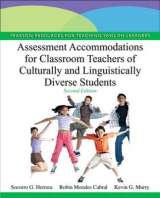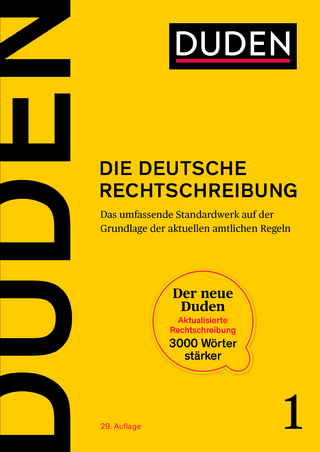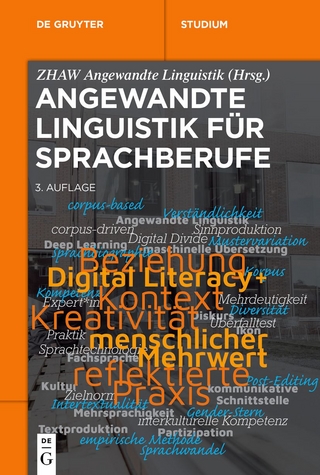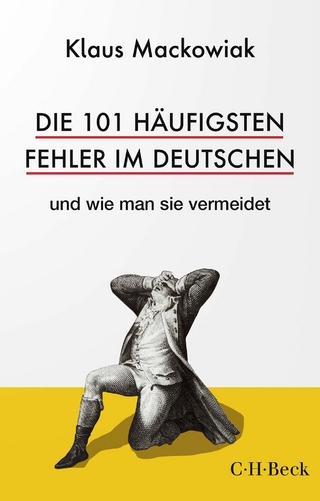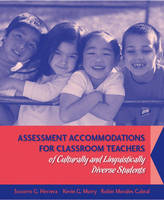
Assessment Accommodations for Classroom Teachers of Culturally and Linguistically Diverse Students
Pearson (Verlag)
978-0-205-49271-8 (ISBN)
- Titel ist leider vergriffen;
keine Neuauflage - Artikel merken
This classroom-ready resource intentionally focuses on those classroom assessment practices that will prove effective with CLD students and useful to preK-12 teachers of those students. Unlike its competitors, the book begins and ends with practical assessment strategies for each of the four critical dimensions of the CLD student biography: the sociocultural, linguistic, academic, and cognitive dimensions.
Dr. Socorro Herrera currently serves as a Professor of Elementary Education at Kansas State and is Director of the Collaborative Intercultural and Multilingual Advocacy (CIMA) Center. Certified in Elementary Education, Bilingual Education, and School Counseling, Dr. Herrera's recent publications have appeared in the Bilingual Research Journal and the Journal of Latinos and Education. Her recent research and teaching in education has emphasized emergent biliteracy, reading strategies, the differential learning needs of second language learners, and mutual accommodation for language learning students. Dr. Herrera has written texts for Pearson/Allyn and Bacon, as well as text chapters for Erlbaum & Associates and ATE/ACEI. Dr. Kevin Murry is currently an Associate Professor of Secondary Education at Kansas State University and is the Director of Research and Development for the CIMA Center. His work in research and development has focused on ESL/dual language programming in secondary public schools and teachers’ accommodation readiness for transnational students. Dr. Murry's recent research has emphasized advocacy frameworks for culturally and linguistically diverse students, the linguistic and cross-cultural dynamics of ESL instruction, portfolio-based practicum experiences, and school restructuring for linguistic diversity. His recent publications have appeared in the Journal of Continuing Higher Education, AACTE Briefs, and the Bilingual Research Journal. Dr. Murry has written texts for Pearson/Allyn and Bacon, as well as text chapters for Erlbaum & Associates and ATE/ACEI. Robin Morales Cabral currently serves as an instructional coordinator for the CIMA Center in the College of Education at Kansas State University. Ms. Cabral prepares school educators to professionally address the social, emotional and learning needs of students in highly diverse K-12 schools. She has a background in communicative disorders and sciences, school leadership, bilingual special education, and assessment for culturally and linguistically diverse (CLD) students. Ms. Cabral’s years of experience as a bilingual speech language pathologist, parent/teacher liaison, intervention coordinator, and assessment specialist, have led to advisory roles with classroom teachers, special educators, and school administrators dedicated to best school and classroom practices necessary to target the individual and collective needs of CLD students.
<>Preface
About the Authors
C h a p t e r 1
Classroom Assessment amidst Cultural and Linguistic Diversity
What’s Different about Today’s Classroom?
Immigration Fallacies and Facts
Immigration Trends and Dynamics in the United States
What’s Changed about the Readiness of Classroom Teachers for Student Diversity?
What’s Evolved about Appropriate Assessment Practices for CLD Students?
C h a p t e r 2
Authentic Assessment
Rationale for the Use of Authentic Assessments
Reliability and Validity of Authentic Assessments
Types of Authentic Assessment
Performance-Based Assessments
Portfolios
Self-Assessment and Peer Assessment
Interview-Based Assessment
Play-Based Assessment
Cooperative Group Assessment
Dialogue Journals and Scaffolded Essays
Scoring and Related Issues of Authentic Assessment
Rubrics
Checklists and Questionnaires
Additional Considerations
FM.i31/2006 8:37:54 AM
C h a p t e r 3
Preinstructional Assessment and the CLD Student
Formal and Informal Preassessment
History/Herstory: What the CLD Student Brings to the Classroom
Biopsychosocial History of the CLD Student
Education History of the CLD Student
Language History of the CLD Student
Preassessment Resources: Home Visits and School Conferences
C h a p t e r 4
Assessment of Acculturation
Acculturation and Enculturation Processes
When What Used to Work No Longer Works
Acculturation Dynamics
Relationship between Cultural Identity and Acculturation
The Role of Acculturation and Emotions in Learning
Assessing Level of Acculturation
Informal Assessment of Acculturation
Formal Assessment of Acculturation
Impact of Acculturation on Appropriate Methods of Assessment
Using Acculturation Information to Inform Instruction
Cultural Differences as Learning Assets
Programming-Related Issues: Assessment of Acculturation
Identification
Placement
Monitoring
Exit
C h a p t e r 5
Assessment of Language Proficiency
Rationale for Language Proficiency Assessment
Rationale for Assessing Primary Language Proficiency
Rationale for Assessing English as a Second Language
Key Elements of Language Acquisition and Proficiency
Syntax
Morphology
Phonology
Semantics
Pragmatics
Informal Assessment of Language Proficiency
Key Issues in Informal Assessment
Home Language Surveys
Parent Interviews
Informal Assessment of Academic Language Proficiency
Formal Assessment of Language Proficiency
Standardized Formal Assessments
of Language Proficiency
Further Considerations
Programming-Related Issues: Language Proficiency
Assessment
Identification
Placement
Monitoring
Exit
C h a p t e r 6
Assessment of Content-Area Learning
Formative Content-Area Assessment
Informal Formative Assessment
Formal Formative Assessment
Summative Content-Area Assessment
Informal Summative Assessment: Portfolios
as Authentic Assessments
Formal Summative Assessment: High-Stakes Tests
The Role of Language in Content-Area Assessment
Bias in Classroom-Based Content-Area Assessments
Programming-Related Issues: Content-Area Assessment
Identification
Placement
Monitoring
Exit
C h a p t e r 7
Special Education Issues in the Assessment of CLD Students
What Is Special Education?
Is Disproportionality Really an Issue?
Why Should We Be Concerned?
Implications for Classroom Teachers
The Importance of Information: Review and Request
Preassessment for Special Education
Attention to the Assessment Process
Reevaluation Considerations
C h a p t e r 8
Postinstructional Assessment
Teacher-Driven Postinstructional Assessment
Linguistic Postinstructional Assessment
Academic Postinstructional Assessment
Cognitive Postinstructional Assessment
Sociocultural Postinstructional Assessment
But What about the Grade?
Conclusion
Appendix: Resource List
Glossary
References
Index
| Erscheint lt. Verlag | 3.1.2007 |
|---|---|
| Sprache | englisch |
| Maße | 191 x 232 mm |
| Gewicht | 572 g |
| Themenwelt | Schulbuch / Wörterbuch ► Wörterbuch / Fremdsprachen |
| Geisteswissenschaften ► Sprach- / Literaturwissenschaft ► Sprachwissenschaft | |
| ISBN-10 | 0-205-49271-1 / 0205492711 |
| ISBN-13 | 978-0-205-49271-8 / 9780205492718 |
| Zustand | Neuware |
| Informationen gemäß Produktsicherheitsverordnung (GPSR) | |
| Haben Sie eine Frage zum Produkt? |
aus dem Bereich
